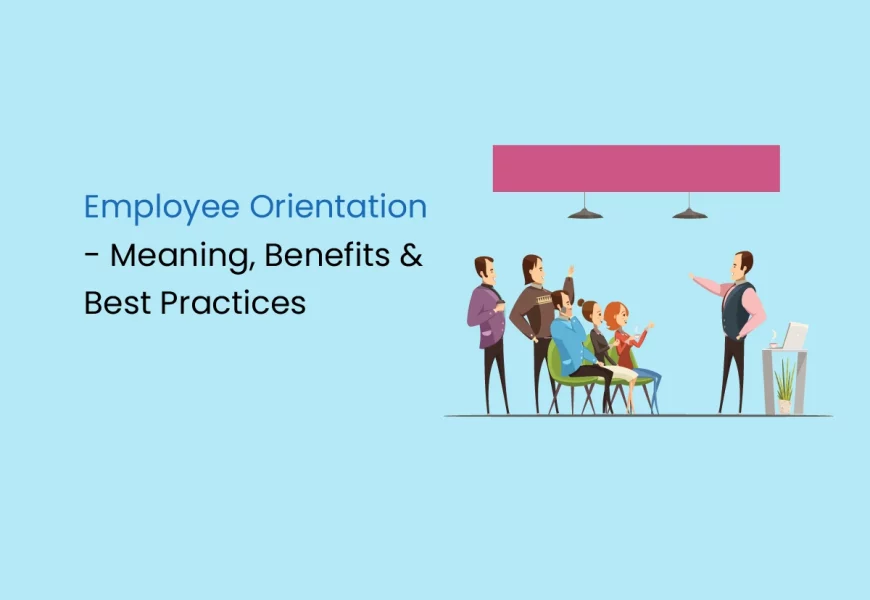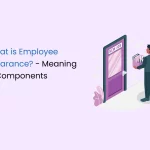Employee orientation is the systematic process by which the new employee can be introduced into the job and guided to grow in the culture of the company. Generally, it occurs within days or weeks after joining a company.
The process could be formal, introducing the new hire and the organization while providing all possible resources, information, and support, leading to a comfortable transition into the new work environment. In this blog we will explore what a successful and fruitful employee orientation process looks like.
What is Employee Orientation?
Employee orientation is a process by which new employees can fit into their new workplace and adapt to the company’s culture, policies, and procedures. It is usually structured and conducted shortly after a new employee joins the organization to ensure that they have the expectations of their role and that of the organization.
Elements of Employee Orientation
- Company Overview: The history of the company, mission, values, goals, and culture are provided to the new hires. This gives them a broader outlook and helps them understand their role in the working process.
- Job Role and Responsibilities: This includes elaboration on the new hire’s role, job responsibilities, performance expectations, and how success will be measured.
- Workplace Policies and Procedures: All aspects of company policies, such as attendance rules, code of conduct, dress code, safety protocols, and data confidentiality, are explained to new employees so that they are clear about what is expected from them in regard to behavior and compliance.
- Introduction to Team and Colleagues: Orientation often includes introducing the new hire to their team members and other key personnel, which helps them feel welcome and begin building relationships from the outset.
- Training and Development: Orientation may also include training or development resources that will help the new hire be more effective in his work. This can include technical training, skill development, or industry-specific certifications needed.
- Benefits and Perks: New employees are orientated with the benefits they get, such as health coverage, retirement savings, and other employee perks the organization provides to its employees.
- Workplace and Safety: The space given to the employee includes explaining where to find the most necessary resources and any health and safety procedures to protect themselves.
Why is Employee Orientation Important?
- First Impressions Matter: The whole process of orientation forms the basis of a new hire’s experience with the company. A positive, well-organized orientation can make new employees feel valued as well as excited about their new role.
- Enhances Retention and Engagement: Employees who feel welcome and informed are more likely to stick around over the long haul and be engaged in their work, owing to a sense of connection with an organization that holds similar objectives and values.
- Quicker Integration: A systematic orientation program enables new employees to become operational as fast as possible. They can quickly learn about the organization, what tools they would need in doing their job, and how to integrate themselves with other colleagues such that the transition is even smoother and faster.
How Employee Orientation Works
- Pre-boarding: Sometimes, orientation begins even before the date of the first working day. Pre-boarding may include mailing the new hire company materials, setting up accounts for systems they will use, and giving them an overview of the company’s culture and values.
- First Day or Week: Usually, the first day or week will be a combination of paperwork to be dealt with, opening accounts, introductory sessions, and meeting the key people in the organization.
- Job-Specific Training: During orientation, the employee will be provided with job-specific training relative to his role. This may include shadowing coworkers, attending job-specific workshops, and being provided with step-by-step instructions on their jobs.
- Follow-up: Employee orientation does not end on day one. Regular follow-ups and feedback sessions with managers or human resources ensure that the newly hired employee is adapting just fine, understands his role, and has access to everything necessary to succeed.
Duration of Employee Orientation
Employee orientation can be a one-day program or sometimes extended to a few weeks. It really depends on the complexity of the job and the company’s own processes in onboarding employees. In most cases, the first days or weeks are about introductions, training, and acculturation to the new employee, who is getting accustomed to the culture of the company. However, the period it takes can be longer to provide continuous development and support.
The Main Elements of an Employee Orientation Program
An effective orientation program should equip employees with the tools and resources necesary. This is essential to help them integrate well into their role. Here are the core elements that any successful orientation process should include:
Welcome and Introduction
- Personal Introduction: Newly hired staff should be greeted with warm smiles and introduced to the key stakeholders of the team, managers, as well as HR personnel. This can be done face-to-face, via video call, or even with a welcoming video that helps form initial contacts.
- Team Introduction: Introducing employees to the broader team makes them feel more connected to the organization. Having the names and roles of their co-workers explained creates early collaboration and communication.
Company Overview
- Mission, Vision, and Values: This covers the company’s mission or purpose (why the company exists), its vision (what the company should achieve), and values or guiding principles that help new employees understand its purpose and culture.
- Company History: A short history of the company’s successes and goals helps establish a sense of belonging in relation to the legacy and long-term objectives of the organization.
- Organizational Structure: An overview of the organizational structure, such as key departments, management, and lines of reporting, would orient employees to how the company is structured and who they might contact for assistance.
Administrative and Legal Procedures
- Paperwork: Completing tax forms, employment contracts, and benefits enrollment forms are among the paperwork needed in the orientation process. This ensures compliance and clarifies the legal rights and responsibilities of both parties.
- Safety and Security Policies: Introduce employees to the workplace safety guidelines, security protocols, access cards or emergency procedures, and other essential health and safety regulations. These help keep employees safe as well as informed.
Job Expectations and Role Clarification
- Job Description and Responsibilities: Orientation thoroughly explains the new hire’s job role, duties, and responsibilities. Clear expectations at the beginning of employment minimize confusion and ensure the new hire understands what is expected of them.
- Performance Metrics: Introduce employees to how their performance will be evaluated, key goals for the role, and what milestones they should work toward in the first months.
Tools, Systems, and Resources
- Technology Setup: General orientation should ensure employees have access to the tools and systems they will use (computers, software, accounts, etc.). This allows employees to hit the ground running by providing them with training or resources on how to use these tools.
- Access to Support: Orientation should explain to newcomers how to access support in IT, HR contacts, and help desks so they know which door to knock on when needing help.
Social Integration and Cultural Fit
- Office Tour: During a face-to-face orientation, the office or workplace tour allows employees to familiarize themselves with the layout, break rooms, meeting spaces, and other important areas.
- Team Culture: Orientation can introduce the team culture, expectations of communication, work dynamics, and unwritten rules of collaboration and feedback.
- Employee Benefits/Perks: It’s the appropriate time to explain the benefits that the employer offers the employee, such as healthcare, retirement savings, etc., and perks, including free lunches, wellness programs, etc. Clarity about these aspects of an employee’s job makes them feel valued and informed.
Best Practices for New Hire Orientation
To create a great and engaging orientation experience, here are some essential practices that will guide your approach:
Include the Right Information
New employees must be given all the necessary information to perform their duties effectively. This includes knowledge of company processes, policies, safety procedures, and technical details related to their job. This will enable them to quickly fit into the workplace and alleviate the anxiety often associated with a new job.
- Paperwork: Complete all legal and regulatory forms, such as W-4, state tax, and the I-9 form.
- Role-Specific Information: Define job expectations, key responsibilities, and performance goals so new employees become comfortable in their new role.
- Health & Safety: Provide critical safety training and office procedures to prepare newly hired employees for emergencies.
Emphasize Company Culture
Orientation is the perfect opportunity to immerse new employees in your company culture. Understanding your organisation’s values, mission, and vision helps new hires feel aligned with the broader goals of the business and understand how their contributions fit into the bigger picture.
- Culture Introduction: Share your company’s history, values, and long-term goals. Use real-world examples of how these values are embodied in everyday actions within the company.
- Visuals and Multimedia: Use videos, photos, and handbooks to highlight the company’s culture. These engaging materials will help new hires connect with your brand more meaningfully.
Engage Leadership
Leadership engagement in the onboarding process makes it feel more impactful and meaningful for the new employees. It will be remembered when senior leaders speak on their roles, the company’s vision, and what they value in an employee.
Interactive Elements: Add interactive elements to your corporate event, like team-building exercises or informal meet-and-greets with various departments, which show how your culture feeds on teamwork and communication.
Tailor the Orientation Process
In today’s world, which is full of digitalization, a tailored orientation experience is also essential. Orientation cannot be “one size fits all.” Otherwise, it may feel impersonal and unhelpful, and new hires are not valued. You have to gather information from them before they come into the organization and have to adapt according to their details.
- Personalized Approach: Learn as much as possible about specific needs of the new hire, including accommodations for disabilities, language preferences, or prior experience, and tailor the orientation materials to reflect those needs.
- Diversity and Inclusion: Be aware of different cultural backgrounds and learning preferences. This is where providing multiple formats of resources, for example visual aids for those who are deaf or hard of hearing, can assist in guaranteeing that all of the participants leave with a positive orientation experience.
- Senior Leader Engagement: Arrange a meet-and-greet or formal presentation with a senior leader or manager to discuss the strategic direction and vision of the company.
- Mentorship: Having mentors from leadership or key departments may make the newcomer feel closer and have more support as they begin their journey with the company.
Dynamic and Conversational
Orientation is most successful when it is an interactive, two-way conversation rather than a one-way experience.
- Open Door Policy: Develop an open-door policy to allow them to ask HR or other team members in case of doubts or misgivings. The employees will feel safe in that new environment.
- Prepare Questions: Prepare questions that will make the new hires reflect on their personal goals and how they align with the company’s mission.
New Hire Orientation Checklist
A checklist of every minute detail will keep you prepared and on track, covering everything you should during the new hire orientation process:
Paperwork
- Employee Provident Fund (EPF) Forms: Forms related to the EPF account, including nomination and contribution details.
- Employee Handbook: The company’s policies, rules, and regulations aligned with Indian labor laws.
- Pan Card: For tax purposes and salary payments.
- Bank Account Details: For salary deposits, generally requiring a cancelled cheque or bank statement.
- Form 16: Income tax form used in India for salary deductions.
- Aadhaar Verification: Government-issued ID proof for KYC (Know Your Customer) and tax purposes.
Company Introduction
- Company Overview
- Brand mission, values, and culture
- Internal cultural overview (videos, handbooks, etc.)
Role-Specific Information
- Job description and key responsibilities
- Departmental processes
- Overview of expectations
Health and Safety
- Office procedures and emergency protocols
- Safety guidelines
Benefits and Compensation
- Compensation structure
- Health insurance options
- Sick leave and overtime policies
Social and Team Activities
- Company social events, team building, and networking
Employee Tools
- Keycard, ID badge, and login credentials
- Work tools (e.g., laptop, software)
Bonus Tips:
- Regular feedback from the new hires ascertains the effectiveness and areas that need improvement.
- Ongoing evaluation: Continuously assess and update your orientation process to stay relevant, engaging, and in step with company values.
- Follow-Up: After the orientation, follow up with new hires to offer more support for questions or to ensure they settle in comfortably.
The Payoff of an Effective Employee Orientation
The time and effort put into a well-planned, engaging, and reflective orientation process may yield huge returns in your organization’s success. Positive orientation also equips employees to be more confident and connected with their jobs, improving job satisfaction and decreasing turnover.
Studies show that companies with proper onboarding processes have increased retention rates and better employee performance. When you make your new hires feel welcome and supported, you set them up to succeed while also contributing to the long-term success of your organization.
Conclusion
New hire orientations should be tailored to the individual worker, including the most critical information to be disseminated and engaging, but with a good balance of essential cultural immersion and leadership involvement. It fosters a connection or understanding that your new hire is well prepared to contribute to their roles and help your team grow.
Tailor your new hire orientations to ensure each employee feels supported, informed, and ready to succeed. Start building a stronger, more connected workforce today! Reach out to TankhaPay to learn how we can transform your onboarding process.
FAQS about Employee Orientation
Why is employee orientation important?
It helps them get familiar with the policies and rules of the organization, their job roles, and the working environment. First-day anxiety is less, the employees become more engrossed, and employees become more retained because employees are assured of being backed in their work.
What should be in an employee orientation program?
The following things should be in an employee orientation program:
- Company overview and its mission
- Policies and procedures: such as what are the working hours and the dress code
- Health and safety measures
- Responsibilities per job
- Benefits and compensations
- Team introduction and the work environment
How to make employee orientation more interesting
You can make orientation more interesting as follows:
- Use multimedia presentations (videos, slideshows)
- Use interactive activities (icebreakers, team-building exercises)
- Conduct office tours or meet-and-greet sessions with key team members
- Provide hands-on role-specific training
What are the benefits of a good employee orientation program?
A good orientation program offers the following benefits:
- Enhanced employee engagement and morale
- Better adaptation to the job and company culture
- Better retention rates and fewer turnovers
- Increased productivity and job satisfaction
How would you measure the success of employee orientation?
Measuring the success of an orientation program can be evaluated in several ways:
- Feedback Surveys from New Hires
- Performance metrics in first few months
- Retention rate and employee turnover
- Whether the new hires quickly became a part of the group or not
How often should employee orientation programs be updated?
Employee orientation programs should be reviewed and updated regularly to reflect changes in company policies, procedures, or technology. The updating of the program will ensure that new hires always get the right information.





















